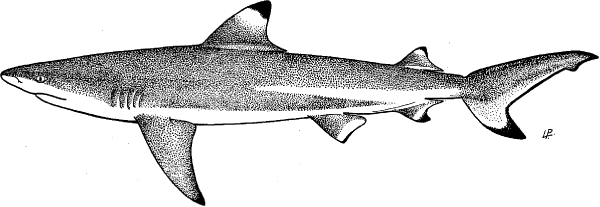| Implanted Tags Record Acoustic Environment of Sharks |
| Principal Investigators: Carl Meyer & Kim Holland |
| |
| Project Overview |
| For decades, biologists have been using telemetry transmitters to study the movement patterns and physiology of free-ranging fishes. Although we have learned a great deal about where fishes and sharks go, we know surprising little about what they are actually doing in the locations that they visit. We are developing and testing new ‘ecology tags’ to detect and quantify hard to observe behaviors such as spawning, schooling and feeding. The sounds produced and encountered by fishes are a source of potentially useful information about their behaviors. Here we describe a pilot study using a sound recording tag (Bioacoustic Probe) to document the acoustic environment of a blacktip reef shark (Carcharhinus melanopterus). |
| |
 |
| |
| Research Questions |
The specific goals of the study were to determine;
- Whether a shark could be successfully implanted with a Bioacoustic Probe?
- whether the implanted tag could successfully record both internal and external environmental sounds?
|
| |
| Methods |
| We implanted a Bioacoustic Probe into the gut cavity of a captive blacktip reef shark to determine whether an implanted tag could successfully record external and internal sounds. The Bioacoustic Probe listening cycle was set to alternately record sound for one hour and then remain dormant for three hours. The shark was kept in a large pen on the coral reef at Coconut Island (Hawaii Institute of Marine Biology). The enclosure contained a variety of naturally-occurring reef fishes and invertebrates (some of which produce sound). One week later, the shark was recaptured, anesthetized and the Bioacoustic Probe was extracted. The incision was then reclosed and the shark resuscitated and released, making a full recovery. |
| |
|
| |
| Results |
| The implanted shark resumed normal swimming immediately after resuscitation and resumed feeding six days after implant surgery. While inside the shark, the Bioacoustic Probe recorded 42 hours of acoustic data, including reef fish vocalizations, boat engine noise, the sound of the shark feeding and rhythmic sounds of the sharks tail beats. These sounds could potentially provide useful information on fish ecology. Fish noises are often associated with specific behaviors such as mating and spawning, and such sounds could reveal when fish implanted with hydrophone tags are associating with spawning events. Boat engine noise could tell us how frequently fish are in proximity of fishing vessels. Sounds associated with feeding could reveal fish foraging strategies. The rhythmic tail beat sounds could provide information on shark or fish physiology and activity rates. The next step is to make these tags smaller and smarter, so that they can analyze and identify sounds ‘onboard’, and transmit their data to remote listening stations. |
| |

|
Figure 1. Spectrogram of Hawaiian Domino Damselfish (Dascyllus albisella) calls recorded by the Bioacoustic Probe while implanted in the gut cavity of a blacktip reef shark. Click on image to hear the sound |
|
| |
| |
| Project Publications |
| Meyer CG, Burgess WC, Papastamatiou YP, Holland KN (2008) Use of an implanted sound recording device (Bioacoustic Probe) to document the acoustic environment of a blacktip reef shark (Carcharhinus melanopterus). Aquatic Living Resources. 20:291–298. |
| |
|
| |
